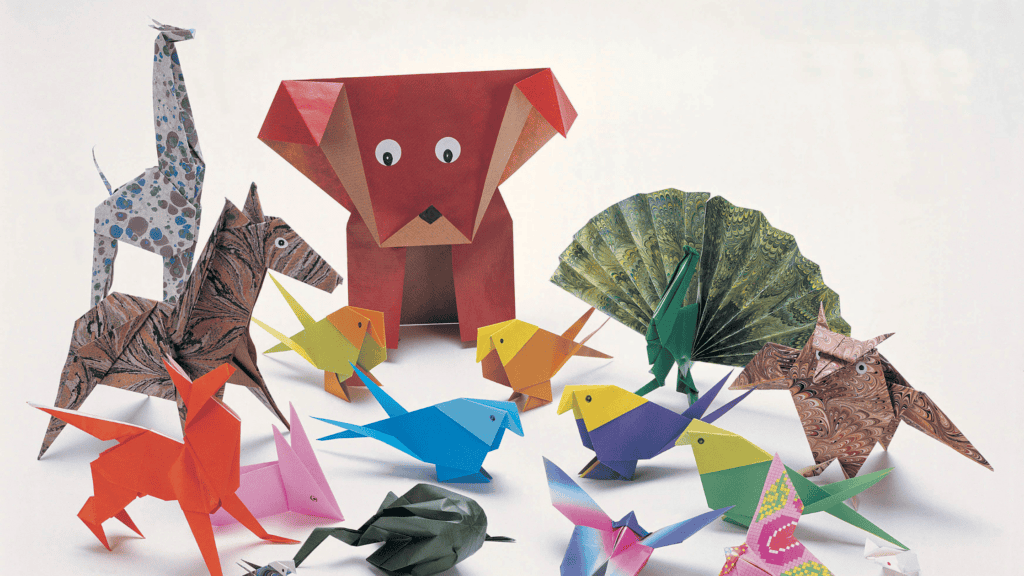Some Tightly Folded Info on Origami

May is Asian & Pacific American Heritage Month (AAPI), and to help celebrate, we decided take a look at the history and origins of origami. And we also held an interview with the ECB’s own Itoko Kobyashi, owner of the brand The Space Waraku, who creates origami crafts.
Origins of Origami
Paper, or more specifically the concept of a “Sheet of Paper”, was first invented in China in 105 AD, during the Han Dynasty. Shortly thereafter (and by “Shortly” I mean 505 years later) the art of Paper Making was introduced to Japan. Historical records on the development of Origami are spotty (and given that paper naturally decays over time, archeologists are unlikely to unearth early examples). The earliest documented mention of Origami is a poem written in 1680 by Ihara Saikak. However, the content of the poem suggests that paper folding was already ingrained in Japanese culture by that point. Paper-folding manuals started appearing in Japan as early as the mid-to-late 1700s, including instructions on creating the classic Paper Crane from a square sheet of paper.
Paper Origami only became truly viable with the invention of a thin, durable form of paper, known as Washi. At first this paper was used primarily for record-keeping and religious ceremonies, including wrapping offerings at shrines. However, this practice later became popular for gift wrapping, including the practice of decorating the gifts with folded ornaments known as girei-ori. During the mid 1300s through the late 1500s, this practice of elaborate gift-wrapping became refined and codified into formal etiquette, by members of the Japanese ruling class. During the Edo Period (1603-1867) Japanese paper production increased dramatically (due to a variety of interconnected economic and cultural factors). This meant that Washi paper was available to a citizenry that was once unable to afford it, allowing the practice of folding paper to become a common and popular pastime among the general population, becoming what we now call Origami.
Origami for a Healthy Mind
Research has shown a variety of benefits to practicing Origami, from helping students develop cognitive processes, to helping adults practice mindfulness.
For students, Origma provides a medium to organically introduce the principles of Geometry, it helps them develop Spatial Visualization, demonstrates the concept of fractions, and introduces them to the basic concepts of architectural engineering. For these reasons and more, Origami has been incorporated into the curriculum of early education in Japan, with great success!
For adults, Origami is an excellent way of learning to let go of self-judgment and perfectionism, accepting that no piece is ever truly perfect, while remembering that we can always make another one. It is also an excellent way of training the mind to focus on one object at a time, improving concentration and mindfulness in our daily lives. One of the most useful elements of Origami is its accessibility and convenience. All one needs is a sheet of paper, and the patience to work through our mistakes.
If you would like to take an origami workshop with us, you can request a class here.
An Interview with Itoko Kobyashi (The Space Waraku)
Itoko is a Japanese immigrant and mix media artist, specializing in Origami interior decorations, and jewelry that incorporates Washi paper. We sat down with Ms Kobyashi, and this is what she had to say:
Q: What got you interested in origami? How did you get started?
A: I create 3D origami. Whenever I create origami works, I feel relaxed and satisfied. That effect encourages me to continue. I started it just after I (had) a baby. It made me satisfied in the chaos of parenthood and dissatisfaction not to read my books. I really recommend origami and other crafts and arts in the busy life to feel happy and contend.
Q: Do you have any major creative inspirations?
A: I just want to make something cute and pretty for my satisfaction and happiness.
Q: What inspired you to start your own business?
A: Surprise of people around me… I have decided to show off my creations. I wanted to participate in the craft fairs and realized I needed to register this something I enjoyed. Straightforwardly, I went to the city hall and registered. This action made my Japanese friends surprised…, too quick.
Q: As someone who was originally from Japan, how have you found the transition to living in the US?
A: Honestly, it was not easy to be familiar with this community. Even now, I have many things which I cannot understand. But I try to go through with my energy and stay enjoying what I am doing. I love to meet people who appreciate what I am doing. I feel I am fine in this crazy society whenever I instruct what I know, origami, calligraphy, and now watercolors with other people. I still try to find something fun and think whether it is possible to share with others.
Q: What advice do you have for people looking to get into origami?
A: I want my students to relax and have fun to improve their motivation, feeling, and possibly physically.
You can browse Itoko’s crafts on her vendor page here. Or if you would like to take an origami class, you can request a class here.
